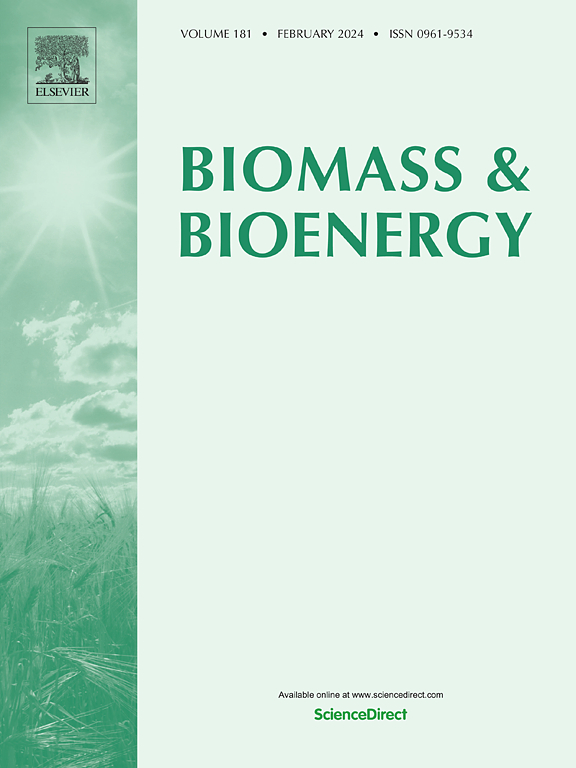生物质气化焦油模型化合物催化重整生产富氢合成气与原位CO2捕获
IF 5.8
2区 生物学
Q1 AGRICULTURAL ENGINEERING
引用次数: 0
摘要
生物质气化制氢作为一种可持续能源技术近年来受到广泛关注。然而,生物质气化过程会产生焦油。这会严重影响后续的气体清洗和利用。在本研究中,甲苯作为焦油模型化合物。考察了不同催化剂载体、重整温度、S/C比和原位CO2捕集对甲苯蒸汽重整收率的影响。结果表明,在相同的工作条件下,SiC载体催化剂的产氢率远高于SiO2和Al2O3载体催化剂。这是由于SiC载体具有优异的导热性和适宜的酸碱性质。CaO能有效吸附CO₂,提高产氢率。添加0.3 g CaO时,产氢率达到90.63%,比未添加CaO时提高13.7%。此外,为了研究催化剂的结构变化和化学状态,采用多种表征方法分析了催化剂使用前后的差异。这项研究为设计有效的催化剂和工艺提供了重要的见解,以克服与生物质衍生焦油相关的挑战。本文章由计算机程序翻译,如有差异,请以英文原文为准。
Production of hydrogen-rich syngas from catalytic reforming of biomass gasification tar model compounds coupled with in-situ CO2 capture
Biomass gasification for hydrogen production has received widespread attention in recent years as a sustainable energy technology. However, the biomass gasification process produces tar. This can seriously affect subsequent gas cleaning and utilization. In this study, toluene was used as a tar model compound. The effects of different catalyst carriers, reforming temperatures, S/C ratio, and in-situ CO2 capture on the yield of toluene steam reforming were investigated. The results showed that under the same working conditions, the hydrogen yield of the SiC carrier catalyst was much higher than that of the SiO2 and Al2O3 carriers. This is due to the excellent thermal conductivity and suitable acid-base properties of the SiC carrier. CaO could effectively adsorb CO₂ and increase the hydrogen yield. The hydrogen yield reached 90.63 % with the addition of 0.3 g of CaO, which was 13.7 % higher than that without the addition of CaO. In addition, to investigate the structural changes and chemical state of the catalysts, the differences between the catalysts before and after use were analyzed using a variety of characterization methods. This study provides critical insights into the design of efficient catalysts and processes for overcoming the challenges associated with biomass-derived tar.
求助全文
通过发布文献求助,成功后即可免费获取论文全文。
去求助
来源期刊

Biomass & Bioenergy
工程技术-能源与燃料
CiteScore
11.50
自引率
3.30%
发文量
258
审稿时长
60 days
期刊介绍:
Biomass & Bioenergy is an international journal publishing original research papers and short communications, review articles and case studies on biological resources, chemical and biological processes, and biomass products for new renewable sources of energy and materials.
The scope of the journal extends to the environmental, management and economic aspects of biomass and bioenergy.
Key areas covered by the journal:
• Biomass: sources, energy crop production processes, genetic improvements, composition. Please note that research on these biomass subjects must be linked directly to bioenergy generation.
• Biological Residues: residues/rests from agricultural production, forestry and plantations (palm, sugar etc), processing industries, and municipal sources (MSW). Papers on the use of biomass residues through innovative processes/technological novelty and/or consideration of feedstock/system sustainability (or unsustainability) are welcomed. However waste treatment processes and pollution control or mitigation which are only tangentially related to bioenergy are not in the scope of the journal, as they are more suited to publications in the environmental arena. Papers that describe conventional waste streams (ie well described in existing literature) that do not empirically address ''new'' added value from the process are not suitable for submission to the journal.
• Bioenergy Processes: fermentations, thermochemical conversions, liquid and gaseous fuels, and petrochemical substitutes
• Bioenergy Utilization: direct combustion, gasification, electricity production, chemical processes, and by-product remediation
• Biomass and the Environment: carbon cycle, the net energy efficiency of bioenergy systems, assessment of sustainability, and biodiversity issues.
 求助内容:
求助内容: 应助结果提醒方式:
应助结果提醒方式:


